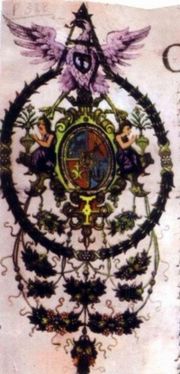
Movilesti
Encyclopedia


According to legend, the family name is connected to the aprod Purice, a low-ranking boyar during the time of Prince Stephen the Great
Stephen III of Moldavia
Stephen III of Moldavia was Prince of Moldavia between 1457 and 1504 and the most prominent representative of the House of Mușat.During his reign, he strengthened Moldavia and maintained its independence against the ambitions of Hungary, Poland, and the...
(ruled 1457–1504). Purice is said to have gained Stephen's recognition after kneeling down and helping the diminutive prince mount a fresh horse during battle. After emerging victorious, the ruler awarded him large estates, and told him that his family was to be known not by the rather crude Purice ("flea"), but as Movilă ("hill").
They rose to political prominence during the latter part of the 16th century. Several of the Movileşti were favourable to an alliance with the Polish-Lithuanian Commonwealth
Polish-Lithuanian Commonwealth
The Polish–Lithuanian Commonwealth was a dualistic state of Poland and Lithuania ruled by a common monarch. It was the largest and one of the most populous countries of 16th- and 17th‑century Europe with some and a multi-ethnic population of 11 million at its peak in the early 17th century...
, intermarried with the Potocki
Potocki
Potocki is the surname of a Polish noble family.-History:The Potocki family is a great artistocratic family originated from Potok in the Kraków Voivodeship; their family name derives from that place name. The family is heavily entwined with the cultural development and history of Poland's Eastern...
family, and took refuge to southern Poland
Poland
Poland , officially the Republic of Poland , is a country in Central Europe bordered by Germany to the west; the Czech Republic and Slovakia to the south; Ukraine, Belarus and Lithuania to the east; and the Baltic Sea and Kaliningrad Oblast, a Russian exclave, to the north...
after being faced with Ottoman
Ottoman Empire
The Ottoman EmpireIt was usually referred to as the "Ottoman Empire", the "Turkish Empire", the "Ottoman Caliphate" or more commonly "Turkey" by its contemporaries...
reprisals (no longer present in the competitions for the throne after 1634). They survived as szlachta
Szlachta
The szlachta was a legally privileged noble class with origins in the Kingdom of Poland. It gained considerable institutional privileges during the 1333-1370 reign of Casimir the Great. In 1413, following a series of tentative personal unions between the Grand Duchy of Lithuania and the Kingdom of...
, being awarded a Polish coat of arms (the Mohyła Coat of Arms).
Princes
In MoldaviaMoldavia
Moldavia is a geographic and historical region and former principality in Eastern Europe, corresponding to the territory between the Eastern Carpathians and the Dniester river...
:
- Ieremia MovilăIeremia MovilaIeremia Movilă was a Hospodar of Moldavia between August 1595 and May 1600, and again between September 1600 and July 10, 1606.-Rule:...
- Simion MovilăSimion MovilaSimion Movilă, a boyar of the Movileşti family, was twice Prince of Wallachia and Prince of Moldavia on one occasion ....
- Mihail Movilă
- Constantin Movilă
- Alexandru Movilă
- Miron Barnovschi-Movilă
- Moise MovilăMoise MovilaMoise Movilă was Voivode of Moldavia twice: between April 28, 1630 and November 1631, and between July 2, 1633 – April 1634. Of the Movileşti boyar and princely family, Moise was Simion Movilă's son and brother of Gabriel Movilă and Mihail Movilă.He obtained the throne from the Ottoman overlord...
In Wallachia
Wallachia
Wallachia or Walachia is a historical and geographical region of Romania. It is situated north of the Danube and south of the Southern Carpathians...
:
- Simion MovilăSimion MovilaSimion Movilă, a boyar of the Movileşti family, was twice Prince of Wallachia and Prince of Moldavia on one occasion ....
- Gabriel MovilăGabriel MovilaGabriel or Gavril Movilă was Prince of Wallachia from June 1618 to July 1620. A Movileşti boyar, Gabriel was a son of Simion Movilă, Prince of Moldavia....
Others
- Petro MohylaPetro MohylaMetropolitan Peter was a Metropolitan of Kiev, Halych and All-Rus' from 1633 until his death. He was born into a Moldavian boyar family — the Movileşti — one that gave Moldavia and Wallachia several rulers, including his father, Ieremia Movilă. His mother, Margareta, was a Hungarian noble lady...
- MetropolitanMetropolitan bishopIn Christian churches with episcopal polity, the rank of metropolitan bishop, or simply metropolitan, pertains to the diocesan bishop or archbishop of a metropolis; that is, the chief city of a historical Roman province, ecclesiastical province, or regional capital.Before the establishment of...
of KievKievKiev or Kyiv is the capital and the largest city of Ukraine, located in the north central part of the country on the Dnieper River. The population as of the 2001 census was 2,611,300. However, higher numbers have been cited in the press....
. - Grigore UrecheGrigore UrecheGrigore Ureche was a Moldavian chronicler who wrote on Moldavian history in his Letopiseţul Ţării Moldovei , covering the period from 1359 to 1594....
- Chronicler and high ranking boyarBoyarA boyar, or bolyar , was a member of the highest rank of the feudal Moscovian, Kievan Rus'ian, Bulgarian, Wallachian, and Moldavian aristocracies, second only to the ruling princes , from the 10th century through the 17th century....
(Logofăt,Spătar and Great Vornic) in Moldavia

